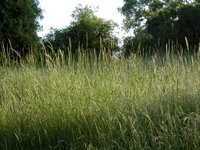
blue wildrye, Elymus glaucus, April–June, Native
Blue wildrye grows aggressively in full sun and canopy openings and in dry to moist soil, and is one of the most common grasses of the West. It grows in grassland, chaparral, woodland, and forest, and is associated on the Preserve with Bromus carinatus. Its grains (seeds) were collected for food; burned grass seeds are conspicuous food remains recovered at local Indian sites.

A short-lived bunchgrass, it can also spread by short stolons, vegetative reproduction being a notable feature of many grasses. The eminent grass specialist Agnes Chase writes, “This ability to make new shoots and cover large areas . . . is an adaptation that allows grasses to dominate open habitats, coexist with grazing animals, and survive fires.” Rhizomes and stolons are specialized stem branches that form at basal stem nodes and grow horizontally. Stem growth resulting in bunch grasses primarily grows up inside the sheath and emerges at its apex.
The inflorescence is a true spike, its individual spikelets, usually in groups of 2, directly attached to nodes of the flowering stalks without pedicels (sessile). Infl. 6 to 16 cm long, not breaking apart with age (look for the old flower stalks); lemma awns 1-3 cm. long. Leaves flat, upper leaf often flag-like (folded at 90º angle to stalk).
Subspecies virescens which has shorter lemma awns, < 5 mm long, has also been reported, but not vouchered, for the Preserve. This grass quite possibly has a sporadic distribution on serpentine but has been overlooked in the field.
Name: ancient Gk name for millet | with a whitish coating.